Have you ever imagined the power of a wall? The Great Wall of China, known as an ancient silk route, was once used by several fearsome dynasties to protect their land. Berlin Wall is another; the building of this wall, in 1961, triggered the game-changing Cold War between the two superpowers of that time.
Murals: tales of hatred and love
Have you ever imagined the power of a wall? The Great Wall of China, known as an ancient silk route, was once used by several fearsome dynasties to protect their land. Berlin Wall is another; the building of this wall, in 1961, triggered the game-changing Cold War between the two superpowers of that time. In our context, Wall of Kindness has been motivating people to share their belongings with others and to be kind. Yes, walls can be powerful enough to impact people and their lives, but it comes down to why and how we use walls. Mural painting is one way of benefiting from the power of walls. Let’s talk about how muralists used walls to spur revolutions, erase hatred and spread the message of love and harmony.
Some believe when it’s not possible to be vocal, your brushes, pastels and charcoal can do the magic. Walls are vast and accessible to all, hence attract a bigger audience. Under strict monarchy, it was not easy for the Arabs to protest, so young artists used walls to convey their messages. The murals aroused even those who were too afraid of their regimes.
Artists were brave enough to draw bold pictures of their oppressors and showed how much they hated them. In a mural, an artist drew Muammar Gaddafi as a rat running away from the trap. While, in Egypt, an artist vented out his anger through depicting an army officer as a giant slayer; in another, an army tank is shown targeting a poor boy on his cycle. To express their political resentment and stir the same emotions in their fellow citizens, walls were used as an effective medium to not just show how they see the world, but to tell stories of their grievances.
Would you paint murals of your cricketers to motivate them to play well? I expect you would say: ‘why not?’ If you know your countrymen are standing by you and celebrating your achievements, you will naturally give your best. Just think of how Serena William could have felt after seeing murals painted to celebrate her successful career as a tennis player. In order to honour William, a group of artists in Brooklyn, painted 21 murals showing some of the special moments from her life in the tennis court.
Creating a ‘Wall of Appreciation’ was another way of paying tribute to Qawwal Amjad Sabri and philanthropist Abdul Sattar Edhi. A team of artists worked together to paint the pictures of the legends on the boundary wall of Memon Technical & Industrial Institute (MITI) in Karachi, which drew attention of the citizens, and will continue to remind them of their priceless contribution to the society.
Lately, we have been seeing young artists and students removing old paint, whitewashing and then painting the walls with spectacular graffiti and murals; their mission is to erase the marks of political, ethnical and religious messages sprawled all over those walls. The initiative by I Am Karachi, ‘Reimagining the walls of Karachi’ really changed the outlook of the city. Fine arts students of various reputable universities in Karachi joined hands to embellish the walls with traditional trucks, elephants, parrots and drawings of Frere Hall, Mohatta Palace, etc. Even in Lahore, initiative like, ‘Street Art Pakistan’ and ‘Karavan heritage mural event’ were extremely successful as the artists were able to showcase their rich heritage and vibrant culture. This is how artists are replacing the rhetoric of hatred with love. Hate messages and negative slogans are now being replaced with murals that make us appreciate the beauty around us.
Murals have been here for a long time, but now they are being taken more seriously. Artists are not just confined to their galleries; they are taking their art to the streets to combat intolerance and to spread peace and love.
Us speaks to Obaid-ur-Rahman, a 24-year-old 3D/Anamorphic Chalk artist and a muralist based in Karachi about his passion and experience of representing Pakistan in the 6th International Street Art Festival in Germany.
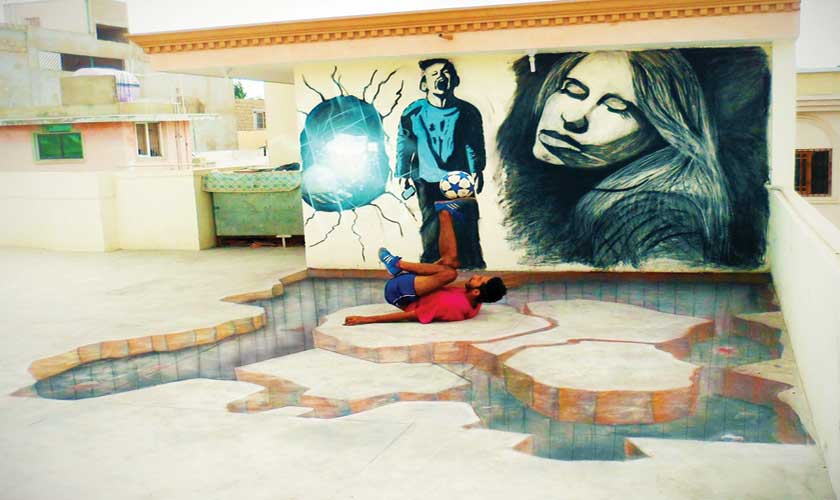
Us: Tell us your story. How did you start with street art? What inspired you?
Obaid: I used to draw, paint random compositions and copy works of graffiti artists on the walls of my roof. One day, it came to me as a surprise when I discovered that the crack I sketched randomly on the ground was 3D art, also known as Anamorphic art. I felt inspired and studied further about this art. Initially, I read books and online material to understand this art, but then, I began to master this art under the mentorship of a renowned 3D street artist, Tracy Lee Stum.
My curiosity kept me going and I experimented with several kinds of compositions ranging from simple cartoon characters to pool drawings to much more complex compositions. And, by the grace of Allah, I have been successful. It was in December 2004 when I was permitted to draw the first 3D picture in the premises of a famous shopping mall (Dolmen Mall) in Karachi. A positive response from the public motivated me to carry on with my newly found passion: 3D art.
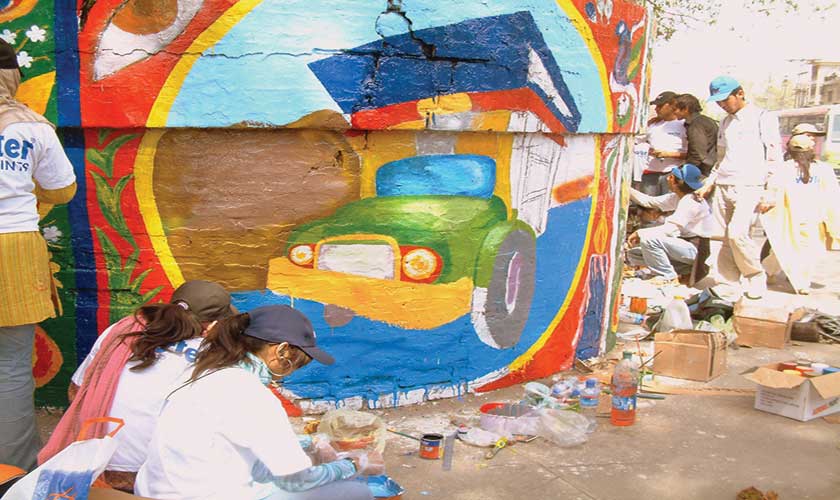
So far, I haven’t faced hurdles of any sort. Yes, there have been a few ups and downs and a few rejections but nothing I would call a hurdle. My parents have been extremely supportive of my choices throughout. They have provided me with all sorts of support possible, and it is because of their tremendous support and prayers I am able to what I do.
3D/Anamorphic Art is a two-dimensional art form, which, when seen from a particular view point through a camera, appears three-dimensional on a flat surface.
Us: Why do you find 3D painting/murals fascinating when there are so many other interesting art forms?
Obaid: Ephemeral art really excited me; as a temporary form of art, it allowed me to fall in love with the process of creation without being worried about how long the artwork would survive. It taught me to enjoy the present moment and not to stress or worry about the future. The other thing that fascinated me was the exposure this art gets: even the smallest of your works becomes special. What actually drives me is the joy I see on people’s faces when they see my work. Everybody is able to freely play and interact with 3D drawings. I think it allows me to be a reason for people to laugh and smile.

Us: You have been a part of different street art initiatives in Pakistan. Tell us about your experience and, in your opinion, why these initiatives are so influential.
Obaid: I worked with I Am Karachi and participated in YALE (Youth Arts and Literary Exhibition). Whenever I am able to work in public, I feel energized: the spontaneous compliments from different walks of life are extremely rewarding. I don’t think I would actually receive this sort of appreciation from my gallery exhibitions. In our country, art is not much appreciated by the general public as very few people visit art galleries. These initiatives help bridging the gap between the public and art, making ordinary people a part of the process.
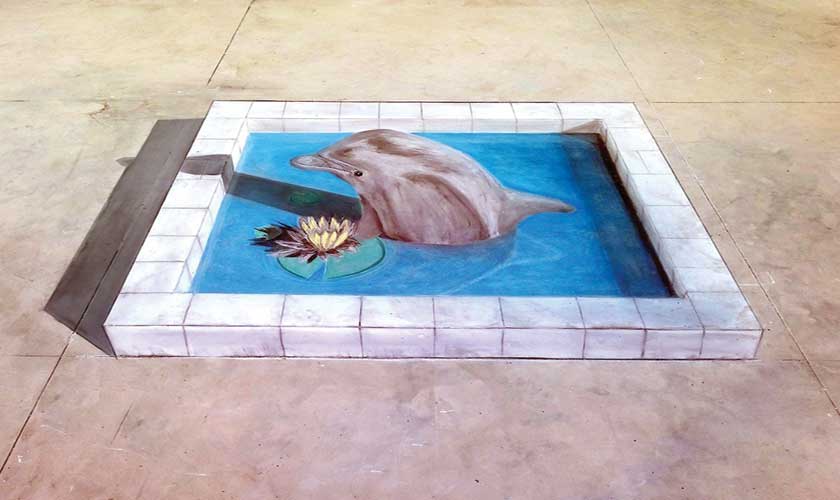
Us: How did you feel about representing Pakistan in the 6th International Street Art Festival in Germany?
Obaid: It has always been a dream to represent my country on an international platform and it came true with this opportunity. Around 45 artists from Mexico, Germany, Italy, France, Turkey, USA, Pakistan, Netherlands, Morocco, Ukraine, Russia, Croatia, Great Britain, Nepal and Japan participated in this festival. It was indeed an honour for me to represent my country, as many artists find it difficult to reach there. Through my participation, I wanted to convey a positive image of Pakistan - to show to the world that we are as peaceful and creative as anyone. All that I am able to do today or have achieved so far is because of Pakistan and to be there as a Pakistani was amazing.
Us: What did you learn from this experience?
Obaid: The overall experience was dreamlike. Two years ago, when I started working as a 3D artist, I couldn’t even have dreamed of taking my work out of my roof to an international arena where I would have a chance to work with the artists I followed and admired! I met those artists in person and observed their work more closely. In this process, I learned about my weaknesses and how I could further polish my skills.
Us: Why did you specifically choose to paint a woman with sitar in her hand? 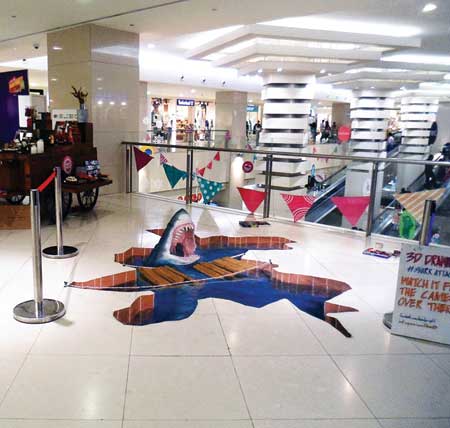
Obaid: Cracks, holes, crevasses and sharks have become clichéd, so I decided to pick up something different. I had been experimenting with different ideas before the exhibition. I love to try challenging ideas, and therefore, I opted to draw a traditional Rajasthani miniature from the 18th century. My hard work was paid off when people stopped by to appreciate it.
Us: As an artist, what do you think could be the value of art in our society?
Obaid: Since Pakistan is a developing country where people seem to struggle for their basic needs, art doesn’t appeal to the public. But with some street art initiatives, things have started to change. Murals do attract people and it’s really good that, now, at least some form of art is available to all.
As a street artist, I think art should act as source of comfort for the people; it should come to them as relief from their daily nuisances. Art should be kept simple with beautiful, pleasing imagery so that people could enjoy it without being worried about the conceptual meaning that it carries; that is when art makes sense to the people and they value it.
Us: Where do you see yourself in the future?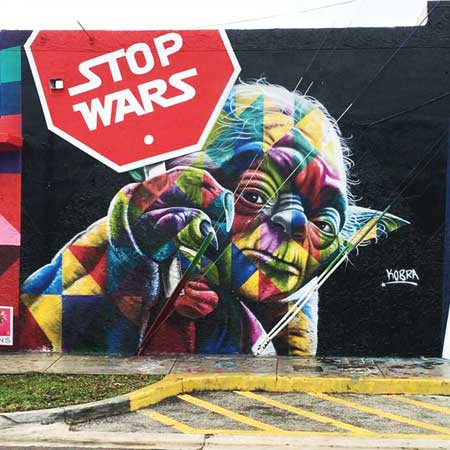
Obaid: I am happy with what I have achieved, but it doesn’t mean I will stop here. My plan is to explore new techniques and experiment with my art. I would switch to different mediums, styles and themes. There are already a few ideas that I have worked on and in the near future I plan to utilise my private space to further my work. I hope to be a part of different public art project where I could freely execute my ideas. I want to take my art out of Karachi to other cities as well and give people a chance to experience 3D/Anamorphic Art. Most importantly, I wish to pass on the knowledge for which I am planning to conduct workshops for aspiring artists.
Us: Any message for the readers?
Obaid: You can still be successful if you follow the mainstream culture, but you cannot feel the joy of being unique. It’s important to go against the common trends to discover your true passion. So, once you know your passions follow them without any fear of failure. Be experimental and do whatever you love, and don’t worry about rejections; they tend to be temporary. You just have to commit yourself to your work and learn from your mistakes, as it is a part of the creative process; just try again and again until you get it right.